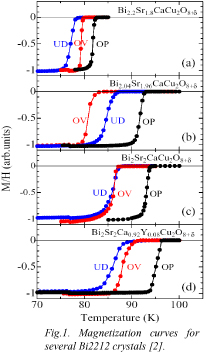| 
One of the specific
subjects under investigation is the role/interplay of microscopic electronic
inhomogeneity and site-specific chemical disorder in the high-temperature
superconductors. Microscopic spatial variations of the carrier density
and superconducting gap were recently observed on Bi2Sr2CaCu2O8+d
(Bi2212) by mean of scanning tunneling microscopy experiments. These
results attracted a lot of attention and were interpreted as evidence
for local charge inhomogeneity, for which an intrinsic nature
and a close connection to superconductivity were suggested [1]. Alternatively
it was proposed that electronic inhomogeneities may also be triggered
by site-specific chemical disorder [2], which was shown to have a dramatic
effect on TC (as shown in Fig.1, the record value of TC=96 K was obtained
for Bi2212 by controlling the amount and location of disorder).
In this regard we are investigating the electronic properties of Bi-cuprates
in which off-stoichiometry and chemical disorders have been carefully
tuned. These more chemically ordered samples are ideally suited to study
the role of charge inhomogeneity by ARPES as well as STM, and also to
address whether long range charged ordering is realized at very low
doping levels, which can be investigated directly by resonant X-ray
scattering experiments. By mean of these comprehensive and complementary
studies we aim at conclusively addressing whether the nanoscale
phase separation is of intrinsic nature in the cuprates and, in
addition, what is the relevance of this phenomenon to high-Tc
superconductivity. |
 |
[1] S.H. Pan et al., Nature 413,
282 (2001); C. Howald et al., Phys. Rev. B 64,
100504 (2001).
[2] H. Eisaki, N. Kaneko, D.L. Feng, A. Damascelli, et al., Phys.
Rev. B 69, (2004) 064512.
|


